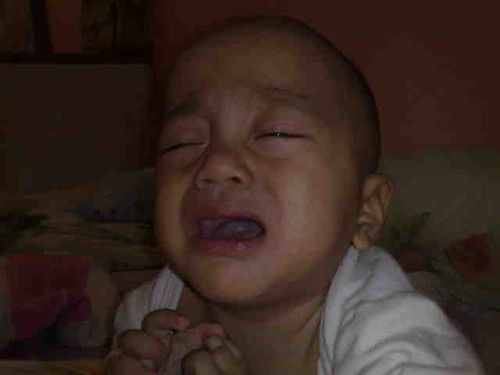Fahry had something on his tounge, it was like milk ‘stain’ and I thought I was so. But after 2 days, the stain was still there, and getting intense. It was like oral ulcer but with no red spot, I still thought it was because of milk.
Several days passed and the stain was still there, getting bigger and whiter.
I was very sure that it wasn’t just a normal thing. I remembered my readings about thrush and I suspected Fahry had one.
So we brought him to Klinik Kanak2 Dr. Altaf at TTDI (Taman Tun, not TTDI Jaya). Dr Wong was in and as he checked Fahry, he confirmed it was thrush and prescibed Daktarin oral gel to be used for 3-4 days.
Thrush or candidiasis is a fungal infection caused by candida. Small amounts of the candida fungus are actually present in our mouth, digestive tract, and skin. It wasn’t give any harm as it is normally kept in check by other bacteria and microorganisms in our body. But when the equilibrium is upset, might be by medication (Fahry took pcm syrup last week), it upset the balance and cause candida to grow.
Candidiasis is something like this

and it often mistaken by ‘sisa-sisa susu’.
To indicate whether it is thrush or milk, try to get rid of it using wet cloth. If it is easily wiped, it is milk but if it’s stay, it could be thrush. It started with a very small white dot and keep on growing. If not treated, it might grow on the whole tongue like the baby in the picture.(crtsy :doctorspiller.com).
Dr Wong told me to not letting him sleeping on breast-pacifier, as the milk might flow while he’s sleeping, and worsen it.
Oral candidiasis, From Wikipedia, the free encyclopedia
Oral candidiasis (also known as “Thrush”[1]:308) is an infection of yeast fungi of the genus Candida on the mucous membranes of the mouth. It is frequently caused by Candida albicans, or less commonly by Candida glabrata or Candida tropicalis. Oral thrush may refer to candidiasis in the mouths of babies, while if occurring in the mouth or throat of adults it may also be termed candidosis or moniliasis.
Symptoms
Oral infections by Candida species usually appear as thick white or cream-coloured deposits on mucosal membranes. The infected mucosa of the mouth may appear inflamed (red and possibly slightly raised). In babies the condition is termed thrush. Adults may experience discomfort or burning.[2]
Special risk groups
* Newborn babies.
* Diabetics with poorly controlled diabetes.
* As a side effect of medication, most commonly having taken antibiotics. Inhaled corticosteroids for treatment of lung conditions (e.g, Asthma or COPD) may also result in oral candidiasis which may be reduced by regularly rinsing the mouth with water after taking the medication.
* People with an immune deficiency (e.g. as a result of AIDS/HIV or chemotherapy treatment).
* Women undergoing hormonal changes, like pregnancy or those on birth control pills.
* People with fresh oral piercings coming into regular contact with yeast.[citation needed]
* Denture users.
* Smokers.
Thrush and breastfeeding
Because of the increased use of antibiotics in laboring women to reduce the transmission of Group B streptococcal infection to the infant, thrush has become more prevalent.[citation needed] Symptoms include an oral rash in the infant’s mouth, a diaper rash that does not heal with conventional diaper rash treatments and ointments, or burning, painful nipples of the breastfeeding mother.
The rash and pain experienced by the mother can range from severe to mild and may complicate breastfeeding. Treatments include good hygiene of the nipples; oral probiotics containing L. acidophilus;[citation needed] and over-the-counter antifungal cream containing nystatin, clotrimazole, or miconazole on the nipples. Some clinicians recommend washing the cream off before breastfeeding.[3]
Treatment
Oral candidiasis can be treated with topical anti-fungal drugs, such as nystatin, miconazole or amphotericin B. Topical therapy is given as an oral suspension which is washed around the mouth and then swallowed by the patient.
Patients who are immunocompromised, either with HIV/AIDS or as a result of chemotherapy, may require systemic treatment with oral or intravenous administered anti-fungals.

See the white little thrush on his tongue?
Leave a Reply